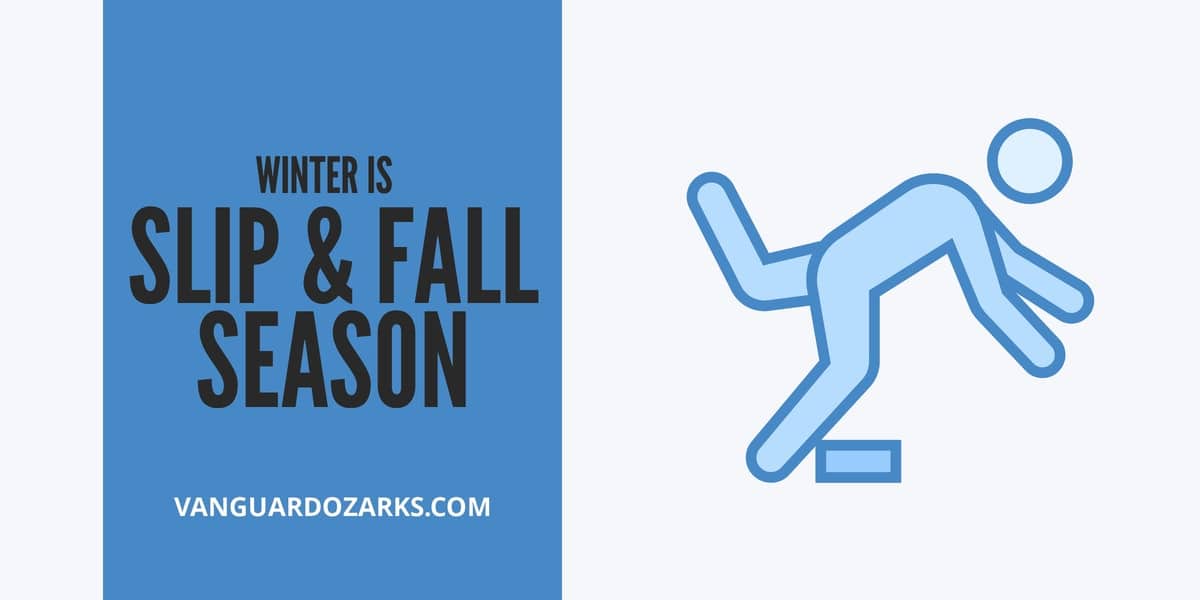Heavy snow and rainfall are predicted to strike all across the midwest and gulf region this winter, increasing the likelihood of dangerous and sometimes litigious slips and falls.

Winter Precautions to Prevents Slips and Falls
Slip and fall accidents--a significant challenge facing schools and businesses-- were, according to the U.S. Bureau of Labor Statistics, the leading cause of workplace injury in 2015, totaling nearly 200,000 claims, resulting in billions of dollars in medical expenses and worker compensation claims.
According to the U.S. Bureau of Labor Statistics, same-level slip and fall accidents are the leading cause of workplace injuries, totaling nearly 200,000 in 2015.
And the 2017 Liberty Mutual Workplace Safety Index reports that these types of falls resulted in almost $11 billion in workers’ compensation and medical costs last year.
Contributing factors to these accidents were:
- Insufficient training.
- Outdated floor matting and cleaning equipment, and;
- The use of unconventional cleaning products.
The two most common factors leading to slip and fall accidents were the placement of low-quality rubber matting and the improper use of string mops, which tend to leave moisture on the floor after use.
Slip and Fall Statistics and Costs
Same-level slip and fall accidents attributed to flooring and floor materials account for approximately 2 million injuries each year, resulting in:
- 5% job-related fatalities for women, and 11% for men.
- $70 billion annually in health-related expenses, and;
- Eight million hospital visits, representing 21.3% of all hospital visits due to injury--the leading cause of such visits in the U.S.
The cost of a slip and fall accident varies based on several factors but ranges from the low tens of thousands to several hundred thousand per incident.
Falls among adults are the most common cause of traumatic brain injury.
Commercial insurer CNA reports that between 2007 and 2012, the average cost of a traumatic brain injury in a general liability claim was $269,643.
The average cost of a traumatic brain injury in workers’ comp claims was $259,153.
Slips and falls that result in general liability claims cost an average of $30,000, while workers’ compensation claims average more than $26,000.
What’s the Cost of a Slip and Fall on a Commercial Property?
Preventing Slip and Fall Accidents
Unsurprisingly, avoiding costly and sometimes deadly slip and fall accidents requires the adherence to strict cleaning and facilities maintenance practices.
Departments that embrace walkway safety as a value, and implement floor safety programs, tend to have fewer slips, trips and falls.
This is important because any reduction in accidents directly improves a company’s bottom line.
Cleaner floors are safer floors, so every good walkway safety program must include a protocol for consistent and effective cleaning practices.
The first step is purchasing and employing cleaning products and equipment that match the type and needs of your floor and environment, with a heavy focus on moisture and grime removal.
According to CNA Financial;
Selecting the right cleaning products for your flooring is critical.
In fact, the very products and methods used to clean and maintain floor surfaces can be the direct cause of slip and fall accidents.
Choosing products that are compatible with your flooring is only part of the equation.
It is essential to ensure maintenance vendors are aware of the proper cleaning products and confirm they are financially stable, ethically sound and operate under a strong risk management structure.
Enhancing Floor Safety Through Slip Resistance Testing, Maintenace Protocols and Risk Awareness
In large commercial buildings, the heavy lifting chore of floor cleaning is typically performed by an advanced floor scrubber.
While the investment in such a device may initially appear expensive, to put it into perspective, a sizeable walk-behind floor scrubber capable of cleaning 150,000 sq ft costs between $13-$18 thousand dollars, while a single slip and fall accident can easily cost twice that.
The placement of high-performance entry and walkway matting that absorbs moisture and debris that would otherwise be tracked across your facilities' floors, while providing additional traction, is the second step in protecting your business and its occupants from slip and fall accidents.
The type, length, and placement of the matting will vary depending on the type of flooring the mat is placed on, the estimated distance necessary to remove debris from the shoes of those entering the building, as well as strategic placement based on foot traffic, and other factors--meaning you should consult with a certified and licensed professional to ensure your organization and those coming in and out of it are properly protected.
Additional Tips to Stop Slips and Falls
- Post warning signs in critical areas with pictures to inform people walking by of the potential dangers.
- Ensure the walkway and entry mats are clean and dry.
- Make certain stairs comply with local building codes, that stair treads are easily visible, and that handrails are firmly mounted.
- Use abrasive tape or coating on floors and replace them as necessary.
- Maintain surveillance of known problem areas or where floor maintenance was recently performed.
- Always clean up spills immediately, and;
- Inspect floors regularly and remove all debris and trip hazards.
A Note on Ice-Melt
In areas where snowfall is common, the conventional solution for dealing with icy, slippery external walkways is to employ chloride ice-melt.
While this type of product can do wonders for eliminating slippery sidewalks, they pose several risks, including:
- Dangers to pet paws.
- Hazards to the environment and local water table.
- Damage to internal facility flooring, and;
- An increased risk of slip and fall accidents inside the facility as a result of mixing commonly used floor cleaning products with the deicer.
An alternative solution is to employ chloride deicers further away from the entrance to buildings, in the parking lot, and along sidewalks, up to approximately 50 ft from the entrance.
Within 50 ft of the entrance, it is advised to use a Green Seal certified liquid deicing product, thereby accomplishing the level of safety while significantly eliminating much of the risk associated with a full application of granular chloride ice-melt.
References & Resources
- How Much Does An Automatic Floor Scrubber Cost?
- Stop The Salt. Your Floors Will Thank You.
- Tips to stop slip and falls
Takeaway
A clean floor is a safe floor, and a safe floor can save your organization tens to hundreds of thousands of dollars in slip and fall accidents, and potentially save a life.
Not all cleaning products and processes are appropriate for every floor type, and a qualified, licensed professional should be used to perform all floor maintenance and cleaning, especially during the winter when the chances of slip and fall accidents increase.
Ongoing custodial staff training is paramount to the success of a safe floor maintenance program, which may prove cost-prohibitive for many organizations.
Outsourcing your facilities' floor care and maintenance program is a cost-effective method for providing the latest in technological tools, cleaning products, and liquid deicing agents without the hassle and expense of recruiting, training, and turnover.
Contact us today and discover why Vanguard Cleaning Systems® is the Standard of Clean® for businesses throughout Northwest Arkansas, Missouri, and Oklahoma.
In Oklahoma, dial 918-960-4450
In Arkansas, dial 479-717-2410
In Missouri, dial 417-812-9777

